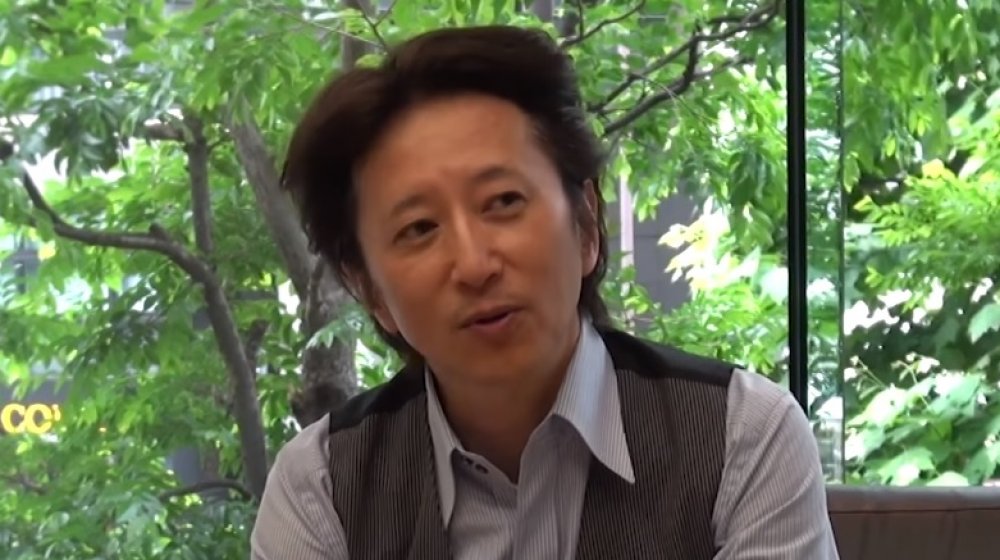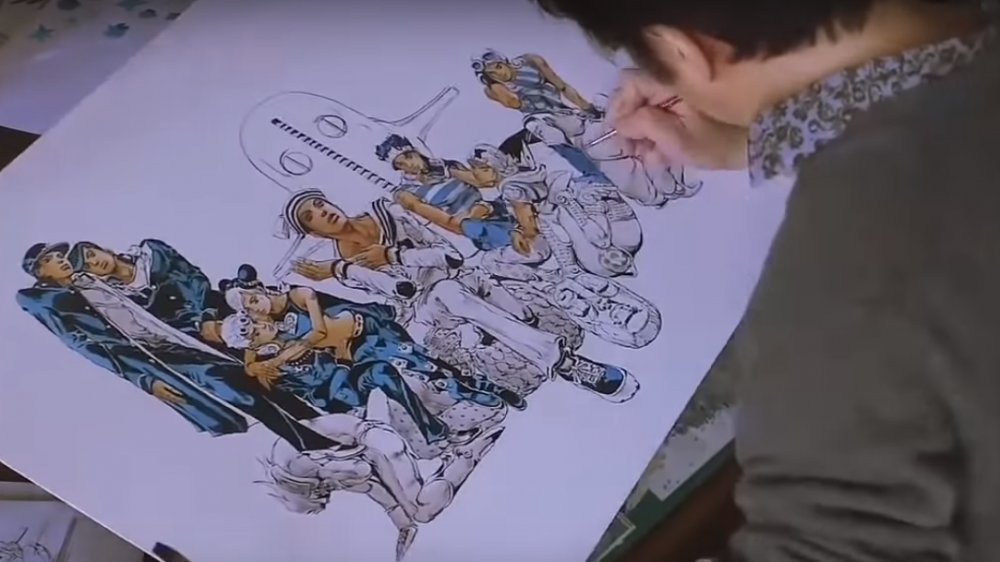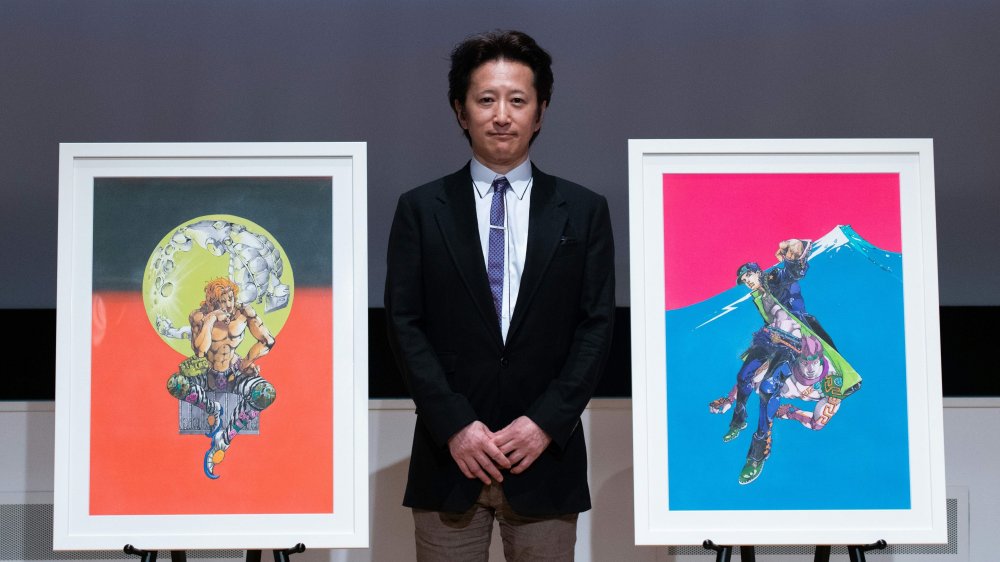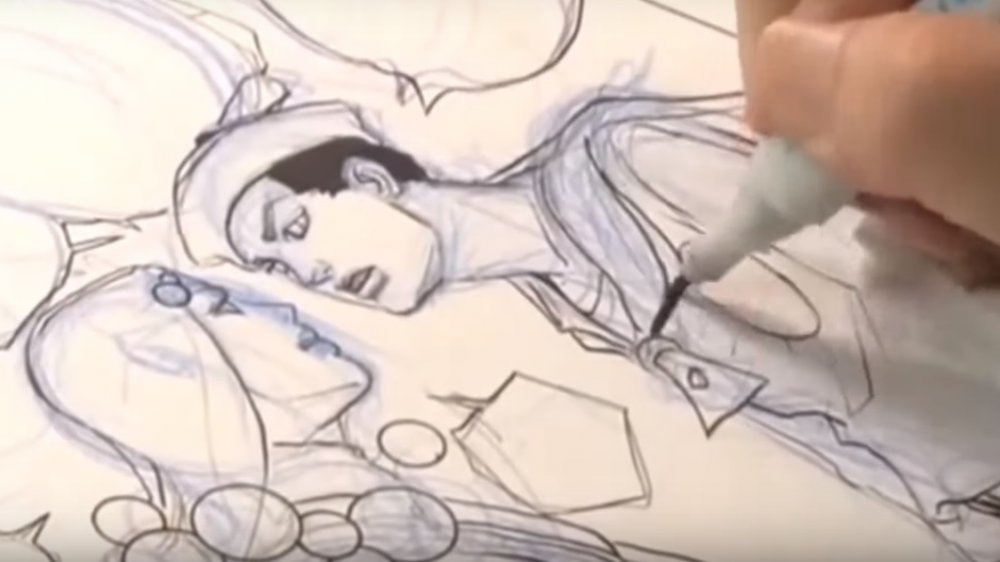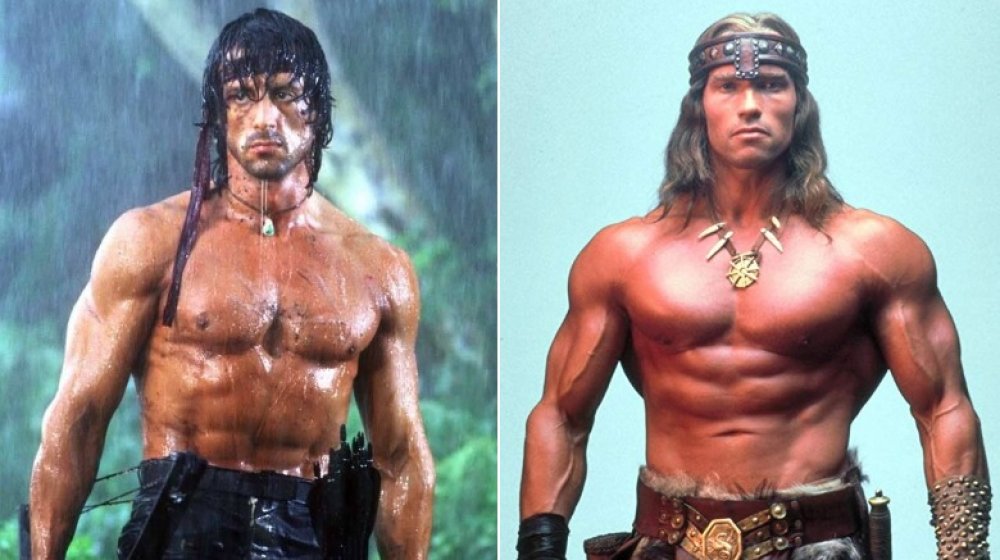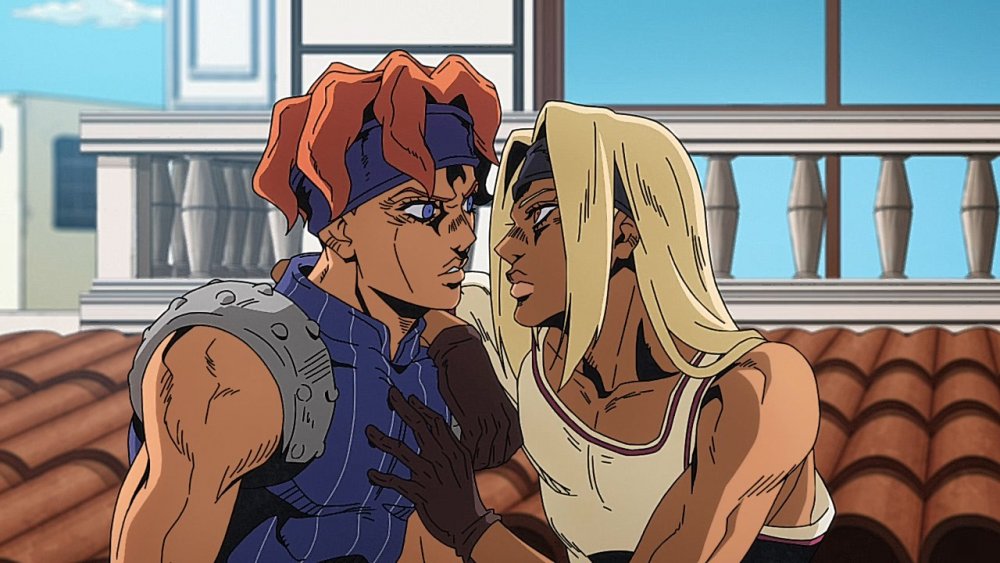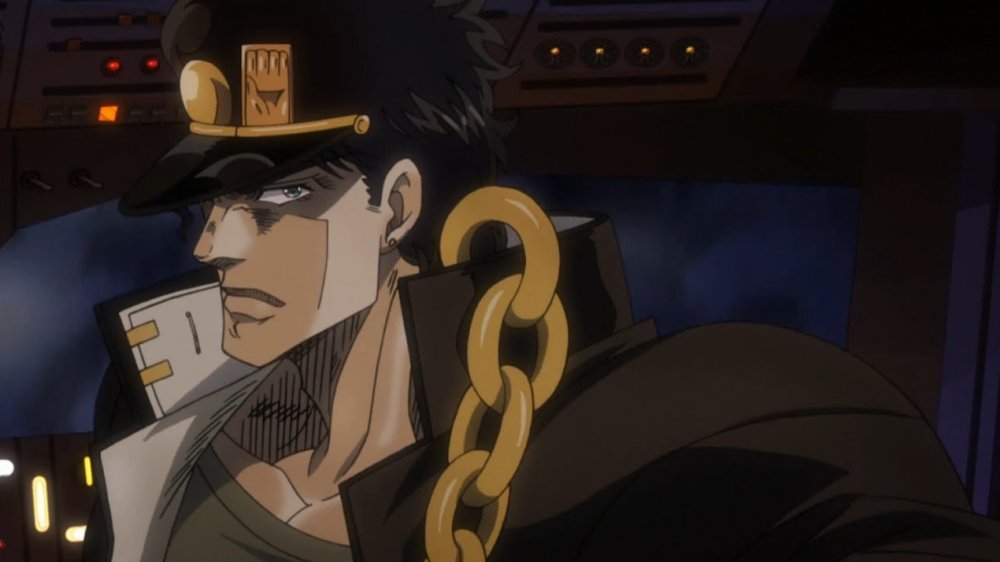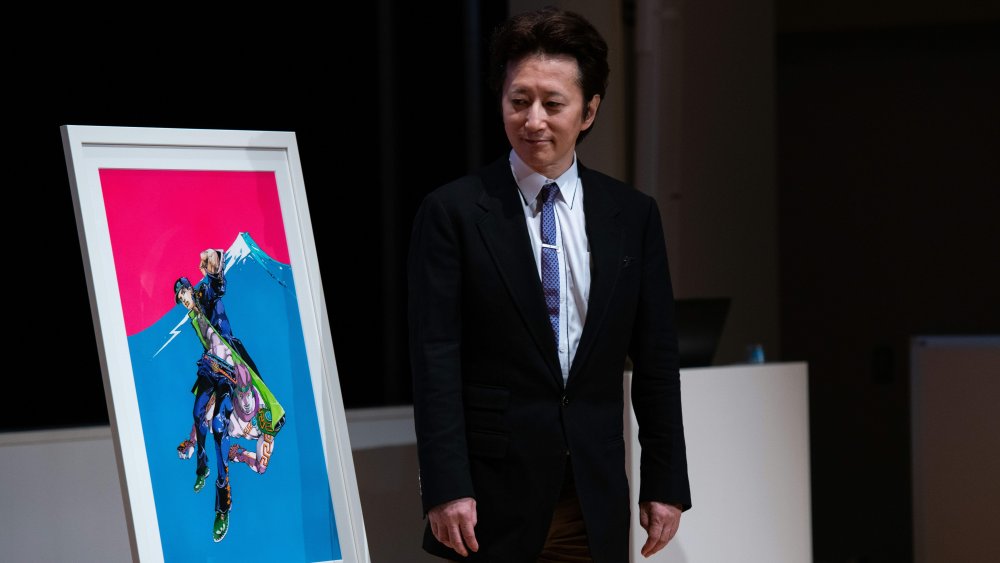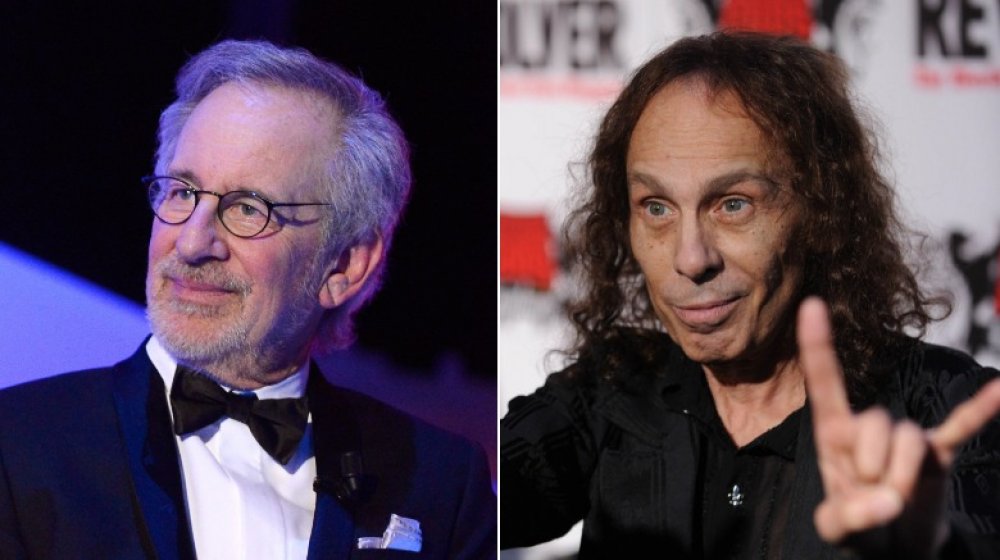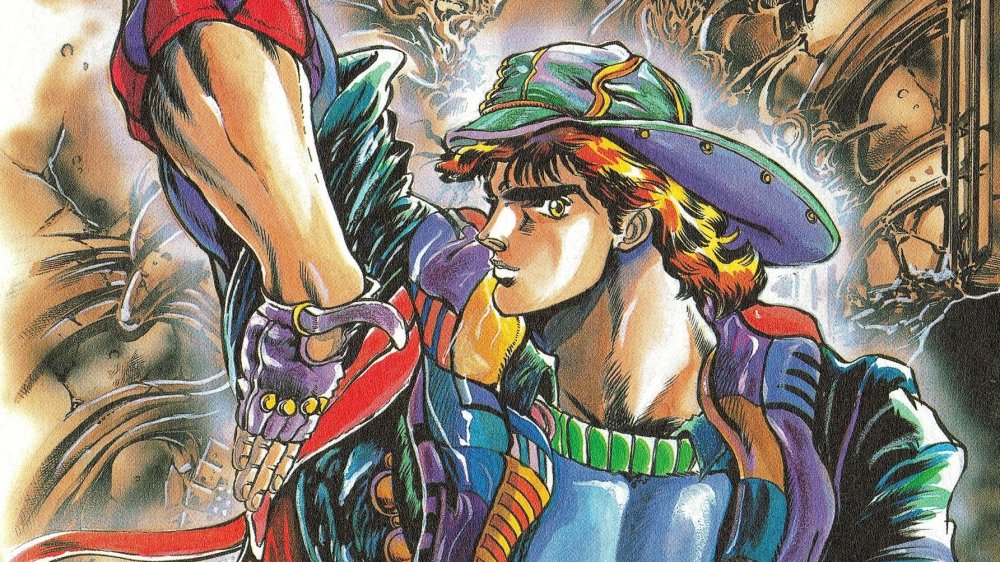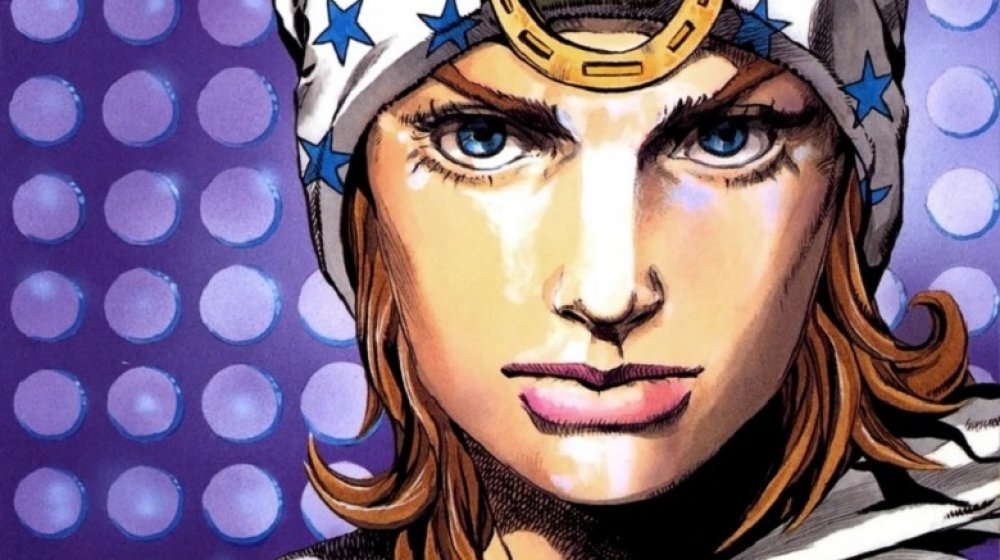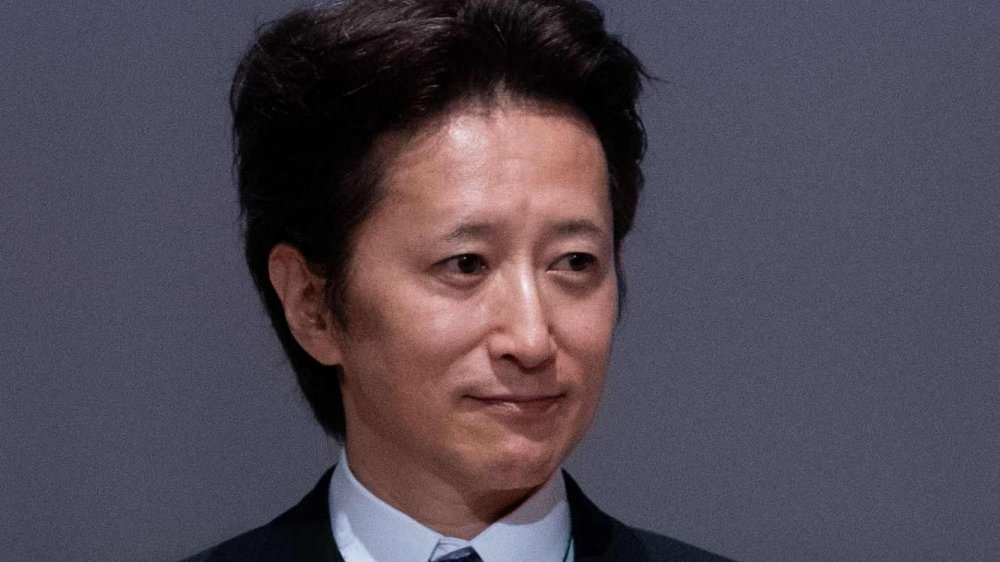The Untold Truth Of Hirohiko Araki
It took a while for Hirohiko Araki's JoJo's Bizarre Adventure to catch on in the States. Viz Media planned to bring Araki's manga to America in the 1990s, but the publisher had a change of heart when BAOH (another Araki title) failed to capture the imagination of foreign fans. A renewed drive to get JoJo's Bizarre Adventure into the western market as a monthly series began in 2002, but that soon stalled. Three years later, U.S. fans finally got the chance to meet the Joestar clan when JoJo Bizarre's Adventure was released in graphic novel form.
JoJo's Bizarre Adventure developed a cult following in the years that followed, producing numerous memorable memes along the way. Araki's magnum opus was well-known in Japan and certain sections of the internet, but it didn't go truly mainstream until Netflix got involved. The streaming giant acquired the rights to the first season of the latest and most popular anime adaptation in 2019, and season 2 of the show was added to its library in 2020, introducing Araki's supernatural fantasy to a whole new audience.
There's more interest in JoJo's Bizarre Adventure than ever, but the man behind the original manga is just as intriguing. From crazy rumors about vampirism to creepy predictions of the future, this is the untold truth of Hirohiko Araki. Minor JoJo's Bizarre Adventure spoilers ahead.
Manga stopped Hirohiko Araki from killing his twin sisters
Hirohiko Araki's father was an office worker who liked to read manga in his downtime, and he passed his passion on to his son. For Araki, manga became more than an interest — it was his escape from his identical twin sisters. When he gave a lecture at Tokai Junior High School in 2006, he revealed that he was often at war with his younger siblings. The mangaka told the sizable crowd (1500 students turned up for his talk, far more than he had expected) that his troublesome siblings would routinely steal his after school snack and conceal the evidence, much to the amusement of the audience.
According to Araki, he would clash with his sisters on a daily basis during his childhood. When he needed to escape he shut himself inside his room where he would read manga and classical art books belonging to his father, influencing his eventual style. He joked that had he not started drawing manga, he "might have gotten out of hand and killed my sisters." Thankfully, that never happened. Araki went on to become "a true manga lifer" according to Jason Thompson, who edited the English language version of JoJo's Bizarre Adventure. "[He's] one of those artists who thrives in the week-after-week deadline struggle, pumping out stories at an amazing pace," Thompson said in a piece he penned for Anime News Network.
The real reason Hirohiko Araki doesn't age
Believe it or not, Hirohiko Araki will turn 60 in 2020. The mangaka's ageless looks have long been a hot topic among his fans, who like to joke that he's immortal and/or a vampire. Ageless Araki has become a popular ongoing meme in Japan. Every time he makes a public appearance, internet users add an up-to-date image of him to a running timeline of his life (his first appearance was around 3000 BC, they claim) and collectively marvel at the fact that he just never seems to change.
Araki's status as a vampire was seemingly confirmed in 2015 when someone ran a picture of him through Microsoft's age-guessing website — he was 55 at the time, but the software claimed he was no older than 27. All joking aside, the man looks very young for his age, so what's his big secret? How come he still looks like a young man when he works a notoriously demanding job? When Anime News Network asked the JoJo's Bizarre Adventure creator if he had any beauty tips for its curious readers, Araki revealed that he keeps a surprisingly simple routine: "Living an orderly lifestyle and face washing with Tokyo tap water."
Hirohiko Araki created his first manga in the 4th grade
Inspired by his father's collection, Hirohiko Araki created his first ever manga in 4th grade. After receiving some encouraging feedback from his classmates, he decided that he wanted to go pro. A number of young manga artists had made breakthroughs at the time, and Araki wanted in. He began sending his work to publishers during his first year of high school, but all of his early submissions were rejected. Undeterred, he traveled to Tokyo to talk with some editors in person.
Speaking during his appearance at Tokai Junior High School, Araki revealed that he initially intended to march into the Shogakukan (publishers of Weekly Shonen Sunday since 1959) office and ask for an explanation, but the sheer size of the building made him nervous. He changed his mind and went to the smaller Shueisha building to make a pitch instead. The editor criticized Araki's manga, but saw potential.
To his surprise, Araki was told to make a number of corrections to his Wild West-themed one-shot Buso Poker (a.k.a. Poker Under Arms) in time for the Tezuka Awards, which was only days away. Buso Poker (1981) was named a Selected Work at the event. Needless to say, the honor was unexpected. "I wasn't clear on what kind of manga artist I wanted to be," Araki said of his debut. "It was like I was just incidentally awarded the Tezuka Award. It wasn't really like I was aiming to win."
Sylvester Stallone and Arnold Schwarzenegger were early influences
When Hirohiko Araki first started working on JoJo's Bizarre Adventure, muscle men were all the rage in Hollywood. He went with muscular body types in Phantom Blood, Battle Tendency and Stardust Crusaders (the first three volumes of his hit manga series) because Sylvester Stallone and Arnold Schwarzenegger were huge at the time, literally and figuratively. Speaking in 2006, Araki said that watching stacked American movie stars in action made him ask the kind of questions he wanted to answer on the page. "They're both muscular characters and their bodies are covered in muscle," he said of Stallone and Schwarzenegger. "I thought stuff like, 'I wonder who the strongest person in the world is?' [That] was the beginning of the idea of JoJo."
Araki moved away from big muscles in Part 4, Diamond is Unbreakable. He decided to start giving his characters more slender frames, which meant returning characters looked very different — the contrast between Part 3 and Part 4 Jotaro Kujo was particularly stark. Jotaro's evolving look has divided fans of JoJo's Bizarre Adventure over the years, but it's hard for a character based on Clint Eastwood to be anything other than cool. Araki has been open about the fact that he modeled Jotaro after the Western legend, who he got the chance to meet in 2012. Araki gave an original Jotaro illustration to Eastwood, who posed as the third JoJo for a photo.
Hirohiko Araki responds to allegations of homophobia
In 2020, a series of screenshots from an interview that Hirohiko Araki gave caused a stir online. The accompanying subtitles appeared to show the respected manga artist making some extremely homophobic remarks (he supposedly says that he's ashamed that JoJo's Bizarre Adventure is big in the LGBT community and that gay people needed to "disappear"), but it didn't take long for those who know Araki's work to point out that these were clearly fake subtitles created by a troll to get a reaction. Unfortunately, not everybody realized that.
Araki addressed the fake interview during a chat with Viz Media, confirming that he remains "a huge supporter" of the LGBT community. "I created many androgynous characters to express what I think," he said. "Scarlet from Part 7 and Dio are both bisexual. There's a rumor that I'm homophobic because of a fake interview, but now I'm going to prove that rumor wrong." Araki proceeded to list a number of ways in which his characters buck gender norms before revealing that the vicious rumors about him being homophobic hurt him deeply. "The fact that thousands of people thought that fake interview was real makes me lose hope in humanity."
Did Hirohiko Araki predict the 9/11 terror attacks?
The world of manga and anime is rife with urban legends, some of them grimmer than others — you might never be able to watch Studio Ghibli classic Spirited Away again once you've read the theory about the bathhouse actually being a brothel. JoJo's Bizarre Adventure: Stardust Crusaders (serialized in Weekly Shonen Jump from 1989 until 1992) gave birth to a particularly compelling urban legend, one that still captivates anime fans to this day. The character Boingo, whose Stand comes in the form of a manga that shows the future via abstract illustrations, appears to predict the 9/11 terror attacks.
In one panel, a Prophet Stand wearing a shirt that appears to read "911" is impaled on a telephone pole from a great height. Below him, an evil-looking plane passes by, smiling. Above him, a crescent moon hangs in the sky. This would have been more than enough material for conspiracy theorists to work with, but there's more. In another panel, the same character (wearing the same shirt, which clearly reads "911" this time) checks his watch and discovers it's 10:30. As it happens, the second Twin Tower collapsed at 10:28.
Hirohiko Araki addressed the longstanding mystery when he sat down for an interview with idol singer and voice actress Shoko Nakagawa, calling it a scary coincidence. "That surprised me," he said of his apparent prediction. "I don't know why I drew such a scene. [...] I don't know what it means."
Hirohiko Araki is a fashion icon
The shift from muscular frames to skinnier ones wasn't the only change that came about as Hirohiko Araki's art style evolved. The mangaka has always been interested in high fashion (he lists Gianni Versace and Christian Dior among his personal heroes), and he started to incorporate his love for flamboyant clothing into his work. "When I create characters' outfits, I am conscious of two elements: daily life and fantasy," he told Anime News Network. "I envision everyday fashion alongside strange, cartoonish, bizarre clothing that would be impractical in real life." Araki's unique approach to outfits made JoJo's Bizarre Adventure synonymous with bold style in Japan, which didn't go unnoticed by the big fashion brands.
Araki collaborated with Gucci in 2011, creating six original illustrations for an exhibition at the brand's Shinjuku location. Also on display was Rohan Kishibe Goes to Gucci, a one-shot that Araki wrote for women's fashion magazine Spur. In it, Rohan investigates a Stand (a visual manifestation of life energy in the JoJo universe) that takes the form of a Gucci handbag. Japanese Gucci stores sold floral-patterned items based on Jolyne Cujoh's wardrobe for a limited time, and JoJo fashion is now starting to take off in the States. Araki is working with footwear brand Vans and Grammy queen Billie Eilish has been pictured wearing a JoJo's Bizarre Adventure shirt, though the singer later admitted she had never read the manga or watched the anime.
The famous names that inspired Hirohiko Araki
When Hirohiko Araki first started meeting with his editor about JoJo's Bizarre Adventure, they would eat at a Jonathan's, a chain of family restaurants. They decided that Jonathan would be a good first name for their main character, and Araki wanted the second name to have a similar sound. Speaking in 2006, the manga artist revealed that he always intended to use alliteration. "So we were thinking of making the name Jonathan 'something,'" he said. "And you know how it can be two S [sounds] like Steven Spielberg? I wanted something like that." He went with Jonathan Joestar, the first JoJo (each part follows a different member of the JoJo family).
Steven Spielberg isn't the only famous person that inspired a JoJo character name. We've already established that Araki is a big movie fan, but he's also really into his rock music. The influence of Prince on JoJo's Bizarre Adventure is abundantly clear (Diamond is Unbreakable protagonist Josuke Higashikata's interests include "playing video games and listening to Prince CDs"), though when it came to naming his first JoJo antagonist, the creator turned to someone a little heavier. Araki named Dio Brando (later referred to as just Dio) partiality after late rock legend Ronnie James Dio, former frontman of Black Sabbath and numerous other bands.
Hirohiko Araki is a manga taboo breaker
Foreign characters are commonplace in manga and anime nowadays, but they were nowhere near as prevalent back when Hirohiko Araki was formulating the idea for JoJo's Bizarre Adventure. It was rare to see a main character that wasn't Japanese in the late '80s, when Japan "reveled in excess and seemed poised to rule the world," as Time magazine put it. With the support of his editor, Araki wanted to venture outside of the Japanese bubble and be one of the first to buck that trend. He made the first JoJo, Jonathan Joestar, a British gentleman in training and set the first part of JoJo's Bizarre Adventure in Liverpool, England.
"That was really adventurous for a shonen manga because it was a taboo to have a foreigner as the main character," Araki said of his decision. "It was that kind of era. It was a big adventure, so I'm really grateful to my editor at the time." JoJo's Bizarre Adventure went to more foreign lands in later parts, including Egypt and Italy. After a reader called him out for a mistake in cyberpunk series BAOH (1984-1985), he made it a rule that if he was going to write about a place, he needed to visit that place in person. "As a result, the Rome I drew captured the real sights of the city, from the buildings to the traffic signals," he wrote in his book Manga in Theory and Practice, transcribed by Redditor MattersMaketh.
The truth about the disabled Joestar
Japan's attitude towards disability has been called into question in the past, though there have been signs of improvement in recent years. Disabled representation in manga and anime can still be a little hit and miss, but Hirohiko Araki has been credited with creating a positive story about a character with a disability — paraplegic former jockey Johnny Joestar. The protagonist of Steel Ball Run and the seventh JoJo in all, Johnny lost the use of his legs after he belittled the wrong person and got shot in the spine. He joins the titular race in order to get his hands on Gyro Zeppeli's Steel Balls, supernatural items that will allow him to walk again.
Johnny eventually gets his hands on the Steel Balls, but he learns some important life lessons along the way, and that's all Araki was concerned with. Speaking to Anime News Network, the mangaka explained that he didn't actually set out to create a disabled character when he was drafting Steel Ball Run. "My work centers around protagonists who grow as they overcome hardship," he said. "[Johnny] was the end result of my pursuit to create a character who could grow, both physically and mentally, during a race where he would be forced not only to rely on other people, but horses as well."
Hirohiko Araki has a few regrets about JoJo's Bizarre Adventure
Hirohiko Araki has been on quite the journey since he dreamed up Jonathan Joestar at his local Jonathan's restaurant back in the 1980s. He had work published prior to that, but the mangaka firmly believes that he "finally became a pro" with JoJo's Bizarre Adventure, which he's clearly very proud of. That doesn't mean Araki has no regrets when it comes to JoJo, however. He's been working on different JoJo-related titles for many years now, so it's only natural that he would look back at some of his older work and want to make a few tweaks here and there.
When he spoke to Anime News Network in 2017, Araki conceded that the Deadly Queen (a.k.a. Killer Queen) Stand from in Part 4 was probably a little over the top. "I felt that I may have made it too strong," he said. "It wouldn't have been a surprise if Josuke was not able to defeat it." His regrets go all the way back to the very first JoJo. Speaking in 2006, Araki admitted that he created characters in a very "'black and white' or "good and evil'" kind of way in those early days, something he would change if he got a do-over. "When I look at him now, I think Jonathan is too much of a good boy," Araki said. "If I was to draw him now, I'd probably show more of the weakness of his heart."
